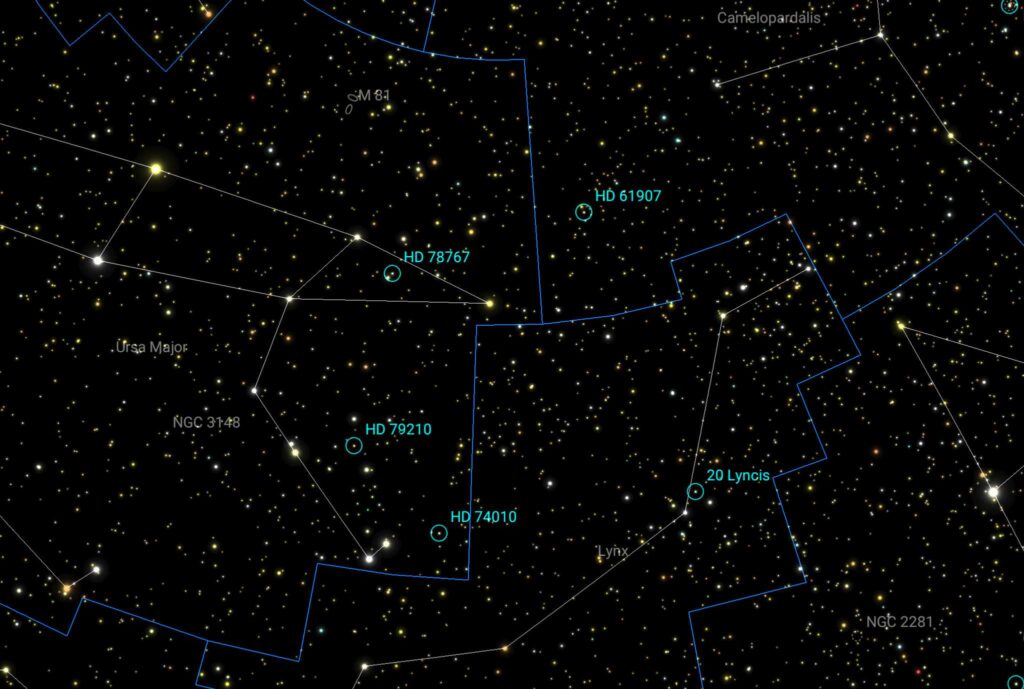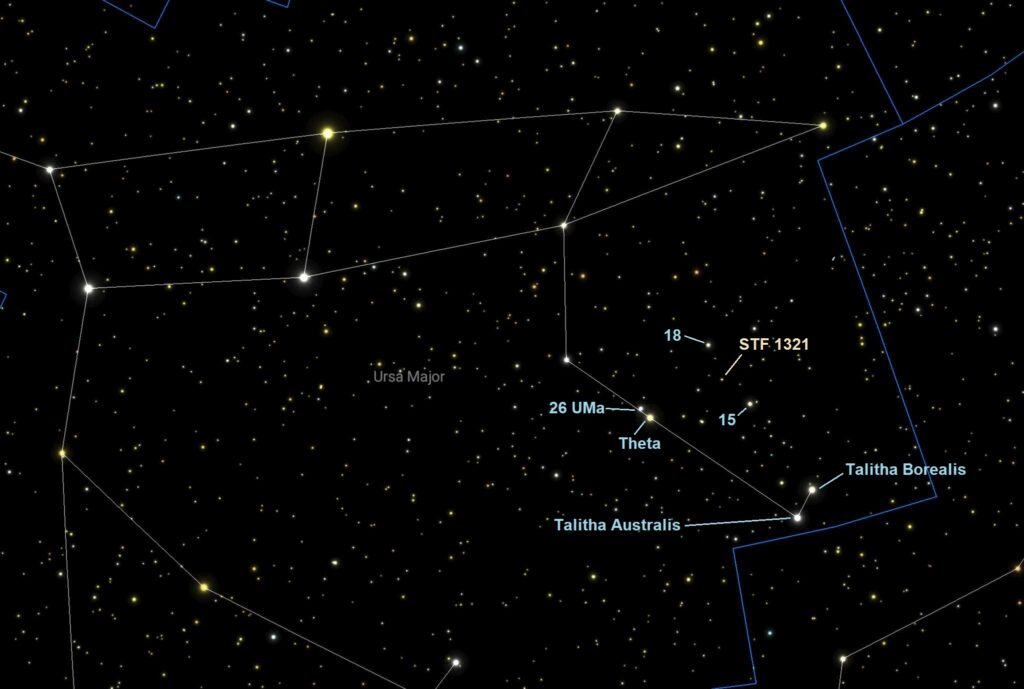A misperception exists about the capability of 10x binocular to resolve closer double stars. The actual limit is much closer than often believed. The closest double star I have resolved with a 10x binocular is 100 Herculis, which has a separation of only 14.3 arc-seconds.
STF 2280 / 100 Herculis
18h07m +26*06′
5.81/5.84 14.3″ pa 183*
A pleasing double at 10x. Two brilliant blue white stars nestled together but fully resolved with the Canon 10x42L handheld and the Maven 10×56 on the Oberwerk PM1 mount.
A key factor is that the instrument must be mounted (or image stabilized like the Canon 10x42L IS). The handheld, non-IS limit is much wider. Also, seated observing is more effective than standing, because it enables a more relaxed and stationary viewing posture making fine detail more easily seen. Another critical factor is that the double star components must be similar in magnitude – if the primary is much brighter than the secondary the resolution limit is wider. The Herculis 100 secondary is only a few hundredths of a magnitude fainter than the primary, in addition to which they are fifth magnitude stars, pretty much ideal for binoculars. I’m not aware of another star that approaches 100 Herculis in this combination of favorable characteristics.
Here is a stelledoppie list of 29 double stars with magnitudes brighter than 8.0, having a difference in magnitude of less than 0.50 and a declination greater than -30 degrees (which is getting far south from my yard in Kansas). 😉

A Sky Safari skylist can be created from StelleDoppie to import as an observing list. Any of the items closer than 100 Herculis are going to be extremely challenging with a 10x binocular, more likely to be seen as two stars in contact or as an elongated star than distinct stars. But worth a try, anyway. If you’re determined to resolve the closer doubles on this list, it would be wise to have a 20x binocular (like the Oberwerk 20×70 ED Ultra) on standby.

This Sky Safari chart shows a few items from the imported 10x doubles skylist, which are labeled by their Henry Draper (HD) catalog numbers. I observed several of them with 10×50 binoculars on Saturday 22 April 2023. Here are my observing notes.
STF 1122 / HD 61907
07h45m +65*09′
7.78/7.80 sep 14.9″ pa 186*
Physical double star
This double in Camelopardalis is what I started the evening with. Seen as evenly matched white stars. I can just resolve them with 10×50 binoculars, but they are much easier with the Oberwerk 15×70 Ultra.
STF 1321 / HD 79210
09h14m +52*41′
7.79/7.88 sep 17″ pa 99.5*
Physical double star
Not quite as difficult to resolve at 10x compared with STF 1122 but still challenging. At 10x it appears as a pair of ivory-colored stars, nearly in contact. But with the 15×70 the stars are seen as deep yellow. Maybe apricot. One of the highlights of the evening. Easily found in the Talitha leg of Ursa Major, between two bright field stars (18 and 15 UMa) west of Theta and 26 UMa. Considerably easier to resolve with 12x binoculars compared to 10x, BTW.



I’m curious to see what the separation limit would go to for 8x’s for myself. I’ve noticed that I can see roughly 60″ doubles while handheld and standing, which comes down to about 26″ seated with a DIY monopod support. No tripod yet, as it is slightly entertaining to try to pick out the double in brief moments of stable arm wobble – more akin to competition shooting than dealing with atmospheric seeing issues at telescopic powers. In either case, those lower limits for separation jump with altitude and magnitude difference.
A tripod would make it easier for sure, but I’m worried that equipment upgrades will only result in an arms race where I pursue closer and more difficult doubles to match. 😛
It’s important to set limits, columbidae. Otherwise, before you know it you have a dozen binocular amounts. 😁 BUT, mounted binoculars are the bomb! With the marvelous Maven b.2 7×45, I can see 100 Herculis as two stars in contact. Will have to try with a few 8x binoculars to see if I can resolve it at 8x.
I don’t believe I have intentionally observed a double star as yet, so 100 Herculis will make a fine first candidate
Awesome list Fiske!!
Unfortunately my astro stable doesn’t (currently) house a decent 10x bino ☹️ but I do own a 15×70 Deluxe that would be a fun optic to use on these 29 targets 😀
I can mount ’em on the 2000 Monopod to add a little more challenge for the wider pairs, then switch to the Paragon-Plus when the splitting starts to get tough.
On a side note: I had planned on getting a 10x50D to go along with my 15x70D, then upgrading my Zhumell Tachyons to the 25x100D-IF, but that plan is on pause because I’ve been rethinking that strategy…. Now my thoughts are on selling the Deluxe & Tachyon and pair down to just 2 binos that would work great on my current mounts:
8x42ED-S and 20x70ED-U
So I’ve narrowed down to two choices that come out to basically the same price:
A) 3 good binos in 10×50, 15×70 & 25×100
or
B) 2 great binos in 8×42 & 20×70
Hmmm….. choices…..
Thanks, Astro! Two good options there, if you ask me. 😉I like option C) 3 good binos 10×50, 15×70, 25×100, and 2 great binos 8×42 and 20×70. 😁